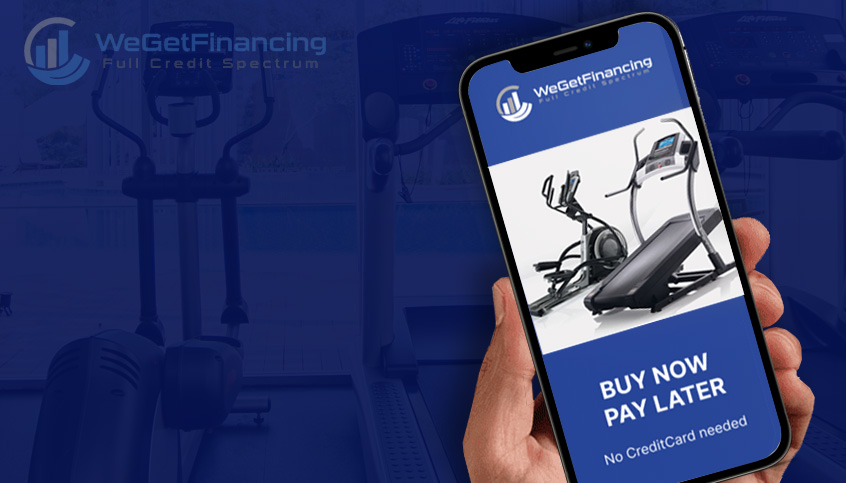In recent years, the shift towards a healthier lifestyle has significantly accelerated, with more individuals seeking ways to incorporate fitness/movement into their daily routines. This surge in health consciousness has notably increased the demand for home fitness equipment as people look for convenient, efficient ways to stay active and healthy from the comfort of their own homes.
Accompanying this growing trend, Buy Now Pay Later (BNPL) solutions and point of sale financing have emerged as game-changers for the fitness equipment industry, offering consumers the flexibility to acquire premium fitness products without financial strain. But why is POS financing becoming indispensable for the fitness equipment industry, and how does it cater to the evolving needs of consumers?
The Fitness Equipment Industry Boom
Historically, fitness has always been dynamic, constantly evolving with societal trends and technological advancements. That said, the shift from communal gyms to personalized home setups is becoming increasingly common today. This is especially marked by the wake of the global pandemic. The closure of public gyms during COVID-19 not only normalized but also necessitated at-home workouts. Thus, propelling the demand for semi-professional fitness equipment to unprecedented heights.
The global home fitness equipment market is projected to grow from $11.60B in 2023 to $16.56B by 2030, a Compound Annual Growth Rate (CAGR) of 5.2%.
Alongside the pandemic, this impressive growth trajectory is supported by several other factors, including rising health alignments, residential infrastructure that accommodates home gyms, accessible fitness apps for real-time monitoring, and the introduction of technology-based workout products by leading manufacturers. For instance, Peloton launched the Bike+ in September 2020, featuring a rotating touchscreen display and connectivity options that exemplified the market’s move towards sophisticated, user-friendly fitness solutions. These factors quickly spiked the demand for residential fitness equipment, making home gyms a staple in many households today.
What’s Popular?
The home fitness equipment market is booming, with more individuals investing in creating personalized gyms within their living spaces. Given the convenience, this means the home fitness trend is not just a fad but a significant shift in how people choose to maintain their regimes.
Though purchases span widely across the board based on individual preferences, the most popular purchases include:
- Stationary Bicycles. Average cost: $500 – $2,000.
- Treadmills. Average cost: $800 – $3,000.
- Rowing Machines. Average cost: $500-$2,000
- Elliptical Machines. Average cost: $600 – $2,500.
- Weightlifting Sets. Average cost: $100 – $1,000.
- Electric Bikes. Average cost: $1,000 – $8,000.
While these enhance the home fitness experience, their high costs can be a significant barrier for many. The high product cost hampers market growth, especially among middle and low-income earners in developing and under-developed countries. Because of that, the financial strain is not just a concern for consumers but also poses a challenge for the fitness equipment industry as a whole and its mission to make quality fitness solutions accessible.
The Solution: Point of Sale Financing
Point of sale and BNPL solutions have revolutionized how consumers shop, allowing them to purchase what they want immediately and pay for them over time. This model of financing has become particularly relevant in industries where high-ticket items are the norm, such as fitness equipment. By integrating the best financing options at the point of sale, merchants can make their products easily attainable to a much broader audience, thereby increasing sales and customer loyalty.
In retrospect, financing solutions empower consumers to invest in better-quality fitness equipment without the immediate financial burden. This model benefits the fitness equipment industry by securing more high-end machines and weight sales. In the same light, consumers no longer have to compromise their fitness goals due to budget constraints, as they have the flexibility to spread the cost over manageable installments.
Benefits Quick View of Such Financing Solutions
- Increased Sales: By offering flexible payment plans, retailers can accommodate a wider customer base, including those hesitant to make large upfront payments.
- Enhanced Customer Satisfaction: Customers appreciate the flexibility and the ability to buy better equipment without financial strain, leading to higher satisfaction and loyalty.
- Competitive Edge: Offering BNPL and POS financing options can set a retailer apart and attract more customers in a competitive market.
- Improved Cash Flow: Retailers can enjoy better cash flow management with immediate payments through financing partners.
Single Lender vs. Multi-Lender Platforms
While single lender buy now pay later options like Affirm, Klarna, and PayPal offer an appealing simplicity and convenience, they typically fall short in catering to the varied financial needs of a diverse customer base. This is because the singular approach of these platforms often doesn’t fully account for the differences in credit histories and financial situations among consumers. Universally, this one-size-fits-all model can lead to customer confusion, frustration, and even lost sales opportunities when financing becomes a stumbling block.
For instance, choosing a BNPL plan that requires four bi-weekly payments over six weeks may not be feasible for customers purchasing high-value items, such as gym equipment often priced over $1,500. In contrast, a multi-lender platform like WeGetFinancing offers more flexible financing solutions, including longer-term loans or leases. By doing so, payments are spread out more comfortably over time, making higher-value purchases more accessible to customers. This approach not only enhances customer satisfaction but can also significantly increase average ticket sizes, conversion rates, and ultimately provide businesses with the growth trajectory they aim for.
Single Lender Platforms:
- Typically offer a one-size-fits-all solution.
- May only accommodate some credit profiles.
- Limit customer options to one set of terms and conditions.
On the other hand, multi-lender platforms such as WeGetFinancing provide a more inclusive solution by connecting customers with a broad spectrum of lenders. This approach ensures that a wider variety of financing options are available, catering to customers across the credit spectrum. The result is boosted conversion rates for merchants and a smoother, more satisfying purchasing experience for consumers.
Multi-Lender Services:
- Provide access to a variety of lenders and financing options.
- Cater to a large range of credit profiles.
- Offer customers the flexibility to choose the best financing solution for their needs.

Future Trends in BNPL and Fitness Equipment
The relationship between fitness equipment and buy now pay later solutions is on target to reach new developments. As BNPL becomes increasingly integrated into the fitness equipment market, consumer purchasing power is growing, and businesses have a powerful solution to drive growth. What could this look like?
Increased Adoption and Integration
As consumer demand for flexible payment options continues to grow, expect to see an increase in the adoption and integration of BNPL solutions by fitness equipment retailers. This movement will likely be fueled by the competitive advantage BNPL offers businesses, attracting a broader customer base through the best financing options that accommodate a range of budgets.
Expansion into Subscription Models
The fitness industry is evolving towards more holistic health solutions, which include not just equipment but also digital fitness programs and personal training sessions. BNPL providers and fitness companies might explore partnerships to offer bundled packages, combining physical equipment with digital wellness services, all under manageable payment plans. This approach could redefine the value proposition of fitness equipment, turning a one-off purchase into an ongoing wellness subscription.
Technological Advancements and Personalization
Tech advancements will undeniably play a key role in the relationship between fitness equipment and BNPL solutions. Innovations in data analytics and AI could enable buy now pay later providers to offer more personalized financing options based on individual consumer behavior and preferences. This level of personalization could enhance the purchasing experience, making it more tailored to individual financial circumstances and fitness goals.
Focus on Financial Wellness
As BNPL solutions become more ingrained in the fitness equipment purchasing process, there’s a growing recognition of the importance of financial wellness. Future trends may include educational initiatives by providers and fitness companies, aimed at helping consumers make informed decisions about financing their fitness equipment. Such efforts could ensure that BNPL remains an effective tool for market accessibility and financial management.
Conclusion: Staying Ahead with BNPL Solutions
The synergy between the fitness equipment industry and BNPL solutions represents a win-win for businesses and consumers alike. By integrating flexible financing options, companies can attract a broader customer base, including those who previously viewed high-end fitness equipment as out of reach.
In conclusion, as the fitness landscape continues to evolve, integrating buy now pay later solutions will be critical for fitness equipment brands looking to maintain a competitive edge. By partnering with multi-lender platforms like WeGetFinancing, fitness equipment retailers can significantly increase the average order value by making high-quality fitness solutions attainable. Even more, become a leading brand that offers the best opportunities for their customers to achieve their fitness goals.
Don’t miss out on the opportunity to elevate your business and meet the needs of your customers. Contact WeGetFinancing today and explore how their multi-lender financing solutions can transform your sales strategy and customer experience.




